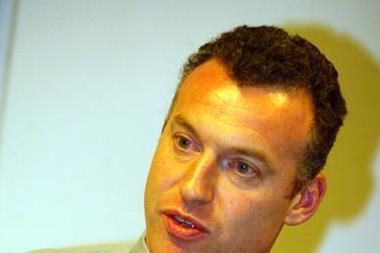Broker networks are ‘this year’s must have’, according to one senior executive. But they are still little guys compared to the Goliaths of the insurance industry who are determined to slash their commissions. Michael Faulkner asks who will win this battle and, over the next eight pages, we investigate the future of networks and meet two of the sector’s best known bosses, Grant Ellis and Stuart Randall.
See also: The players & The tough talker
Insurers' battle to reduce distribution costs has moved into a new phase. Last month it emerged that Norwich Union was threatening to withdraw its support from some networks and alliances as it looked to reign in distribution costs.
The insurance giant said it would prefer to deal directly with brokers rather than pay inflated commissions to networks that were adding little value in the distribution chain.
The move was the natural progression of NU’s much publicised, hard line stance on commissions, which had seen it attack the unsustainable levels of commission demanded by some brokers and re-focus on the small and medium-sized brokers.
It also signalled an evolution in the insurance industry’s debate over distribution costs. Networks had become the next focus for insurers in their quest to keep in check the spiralling cost of distribution through the intermediary channel.
For some time the focus of insurers has been on the high commissions demanded by the consolidating brokers.
Senior insurance executives, from Igal Mayer, chief executive of NU’s general insurance business, to former AXA Insurance chief Peter Hubbard had warned that commission levels had become unsustainably high.
Brokers were told that they had to demonstrate the value they added to the distribution equation in their negotiations over commission levels. Now insurers have moved their sights to broker networks, asking whether the commercial arrangements with these distribution channels provide value for money.
The last year has seen fierce competition amongst the broker networks, with a number of new networks forming and more established networks pushing hard to growth their market share. One senior industry executive has quipped that networks were this year’s must-have fashion accessory.
Networks and alliances can be attractive to insurers as they can provide large volumes of business with potentially lower transaction costs. This enables the networks and alliances potentially to negotiate additional commission from insurers in return, typically between one and three per cent.
“If a network delivers natural value for its members and for Norwich Union then fine,” says George Berrie, director of trading at NU.
NU says it will continue to work with networks and alliances but there must be a commercial advantage in doing so. Executives at the insurer are currently engaged in talks with the bosses of networks and alliances
And NU is not the only insurer that is examining the cost of distributing through networks and other buying clubs; other major insurers are believed to be taking similar action.
Allianz is another insurer that is examining the cost of dealing with networks and alliances. Chris Hanks Allianz Commercial general manager says: “Networks are important; they are a viable distribution route, but some are better value than others. We are in the process of discussing with them what value they each add.
Hanks says that each network varies in the amount of additional commission it takes for members and the organisation operating the network, as well as the services offered.
He says remuneration has become too high and he expects it to come down. “Networks have their noses in the trough making them more expensive to deal with. You just have to balance that with what you get in return.
“All networks have an inflated ideal of what they can achieve in terns of moving books of business to partner insurers. All have had issues with this. Networks that take additional commission and add very little will see their commissions cut.”
RSA and AXA are also looking at the value delivered by networks.
“Networks have their noses in the trough, making them more expensive to deal with. You have to balance that with what you get in return.
Chris Hanks, Allianz
RSA’s new UK insurance chief executive Adrian Brown says: “There’ll be good clubs and bad clubs; clubs or networks which exert control and bring added value, and there’ll be clubs which poorly execute and don’t deliver that.
“Over time, you take a view. Is that relationship working? Part of that will be whether the network is embracing its members and the members are following what it’s doing.
“Networks or clubs work if there’s a compelling reason or proposition. Part of our job is to work with them and see if there are things we can do to help them work. If there are, great, if there’s not, then we should walk away from each other.”
Anthony Middle, managing director of AXA’s commercial lines intermediary division says: "Commission needs to be truly reflective of the value provided by the intermediary to the end customer. Market conditions are particularly challenging currently and we need to focus on costs. This applies to both the cost of distribution across all channels and the operational efficiency of our business.
"We are consistent in expressing our very strong views over the sustainability of high commission levels. We are determined to work with brokers on an individual basis to ensure that our trading partnerships are mutually viable."
Ian Clark, insurance partner at professional services firm Deloitte, says the market cycle plays a key role in the timing of the discussions.
“Cutting commissions is difficult in a soft market as insurers risk losing volume. But as market turns they can adjust commissions without a detrimental effect on both parties,” says Clark. This is because in a hardening market premium volumes increase as rates rise, which means insurers’ revenues and brokers’ commissions are maintained.
Clark says RSA has led the way in tackling rising distribution costs, followed by AXA and NU, both of which have been more vocal in this. “They [insurers] started with Towergate, then moved to the other consolidators and then to networks.”
He points out that as insurers begin to squeeze networks’ commissions they risk encouraging brokers to sell to the consolidators, which would be counter productive.
Networks were a “godsend” to insurers as they provided a counter balance to the consolidators, says Clark, which is why they were originally cultivated with incentives such as additional remuneration.
NU is therefore pushing its Club 110 scheme, which provides benefits and support to smaller brokers, to provide an incentive to not sell to a consolidator, says Clark.
With the flurry of networks starting up, such as Jelf’s Purple Partnership and OurNetwork, how will they fare against the established networks when it comes to demonstrating their value to insurers?
It would appear that the younger networks have a tougher battle on their hands.
Hanks say: “The established ones have a track record, whereas the new ones have something to prove. We may not be as generous with them [the news ones] as we once were.”
Kate Penrose a director of insurance consultancy Salient Solutions says: “The more established and large networks have been able to demonstrate value to insurers. They have a number of members with a degree of loyalty and with predictable behaviour so insurers can get volume - so they will pay higher commissions.
“New networks don’t have the critical mass in terms of members. Until they have scale they can’t negotiate good commissions.”
Penrose says established networks should not be complacent and must continue to develop their business model.
“Established networks need to show they are developing with the market. They need to consider the impact of consolidation on their membership base and they need to show a strongly developed strategy.”
“The large networks have been able to demonstrate value. New networks do not have the critical mass in terms of members. Until they do, they cannot negotiate good commissions.
Kate Penrose, Salient Solutions
Hanks say the challenge for networks is to become more efficient and to fine tune their membership base to ensure it provides the right business in sufficient volumes to partner insurers. “They need to have more commonality in their membership to provide a homogenous buying group,” he says.
It is clear that some networks will be under pressure from their insurer partners. Penrose comments: “Insurers are looking at profitability and over next few months, they will make some tough decisions.”
As a result, some networks may disband while other might merge, she argues.
Deloitte’s Clark argues that networks will continue to have a strong future, because of they value they can add to insurers. “I don’t expect a significant impact on network’s commissions – a slight tweaking. But I would expect some consolidation amongst the networks, due to lack of [premium] volume.”
There have already been signs of consolidation in the network arena. Broker Network has been in talks with Westinsure, although as a deal has yet to be agreed. There is speculation that an agreement is imminent.
Listed broking group Cobra, which includes a network, received an approach from an unidentified suitor.
Hanks says: “There is not room for as many networks as there are now. Some will die, some will merge and some will see their members join consolidators.”
David Hopwood, managing director of network Layton Blackham Business Solutions, says he has not had any conversations with insurers about reducing commissions.
“We spend a lot of time talking to our insurer partners about the value we bring,” he says.
He says LBBS helps to market insurers’ products, requires members to use one of two software platforms, and has an in-house underwriting company to reduce further the amount of work the insurer has to do.
But Hopwood expects some networks will find their commissions reduced, which will ultimately be passed on to the members. “This will reduce the brokers’ earnings, which may cause them to leave in some cases, but they will probably still earn more than if they dealt directly with the insurer.”
LLBS, which is part of Axa’s Venture Preference, has 43 network members and 21 start-up brokers which it supports.
Paul Brierley managing director of OurNetwork, which launched in August, says he had been careful to approach insurers with a sustainable model. “We have been keen to demonstrate we deliver value. We have an online delivery platform which cuts costs.”
Brierley says the reaction from insurers has been positive. “We’ve had no negative reaction from insurers. Some have been positively welcoming.”
OurNetwork, which is aimed at IIB members, has negotiated around two or three per cent additional commission from insurers.
The network has now signed up 75 members “The trick will be to get the members to be active members,” he says.
Brierley says there has been a lot of rhetoric from insurers on commissions. But he does expect this to lead to some networks seeing their commission cuts. And while this will, by definition, mean the affected networks become less attractive, he is not sure that this alone will drive consolidation in the sector.
Nonetheless, he expects some networks will merge in the next two years. “There are a lot of people in this space.”


































